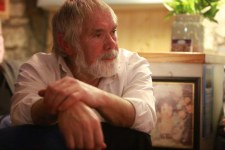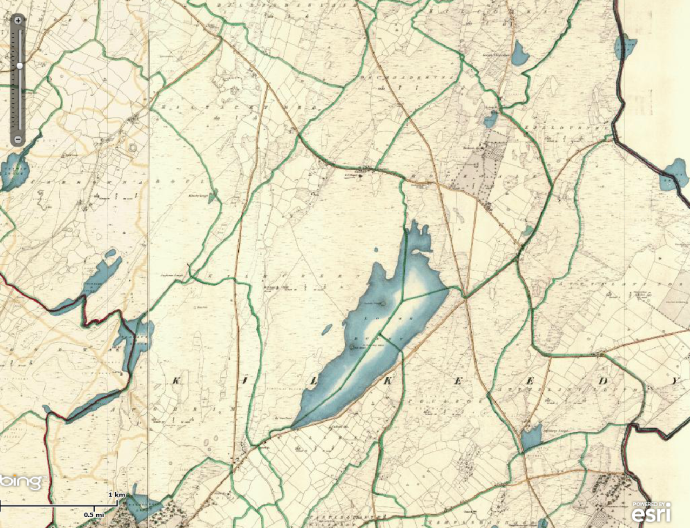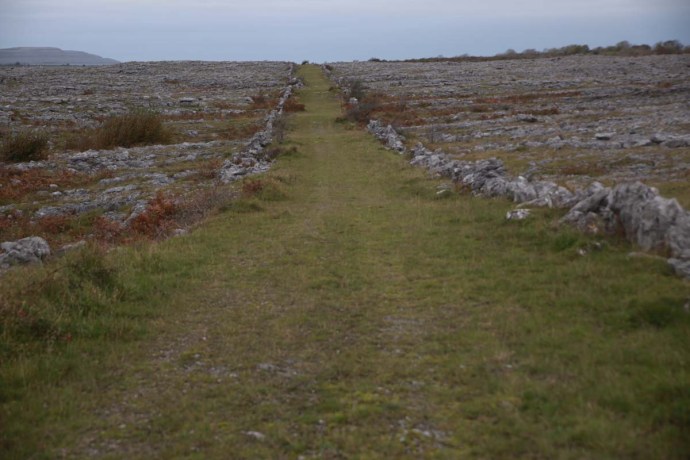
Early in November I went to my first organised singing session since I came to Ireland. I know that’s a terrible admission especially as my start in Irish music came from my interest in folk singing back in the 60s. It was from singing Bob Dylan and Phil Ochs and Pete Seeger and Ewan McColl, and then traditional Australian songs, that I discovered the original “protest” songs coming from Ireland and Scotland. Of course the fiddle sort of took over but I still love singing and squeeze the odd song into a trad session if I get the nod. My knowledge of the singing session was scratchy to be sure and probably an entrenched stereotype. You know; finger in the ear stuff and all 47 verses of Lord Thomas and Fair Eleanor.
So when Mary Butler, proprietor of Kilshanny House near Ennistymon, asked me to come along to the once-a-month Kilshanny Singing Circle, I had no great expectations. It was certainly a world away from the Pub Trad Sessions, my natural habitat.

Mine hosts, Aidan and Mary.
A crowd slowly gathered on the chilly November night. Many turned out to be singers but others were just there to listen. Indeed there were at least 25 singers (actually 24 singers and one Singer – sorry that’s an attempt at humour), some sitting in a circle as you would expect in a session but many others just hovering or sitting at the bar in relative anonymity.
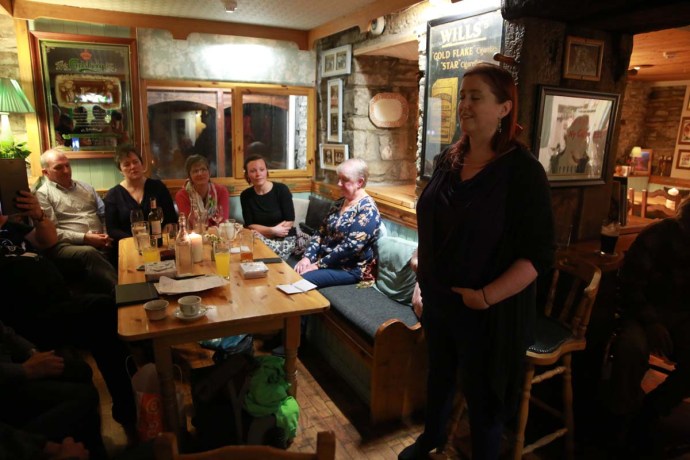
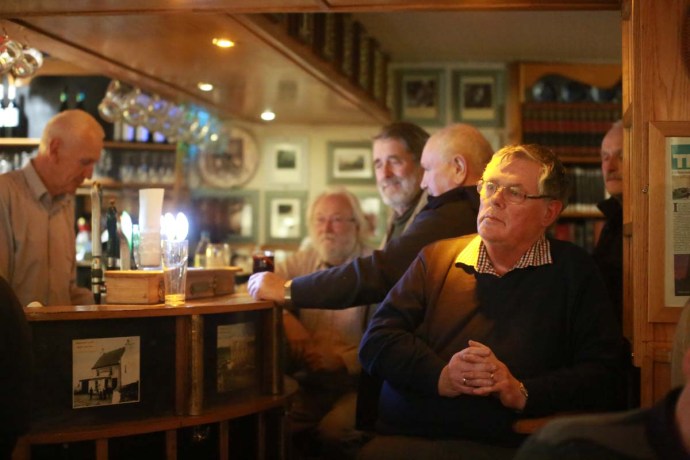
Enter a caption



The night was masterfully run by local Ennis based singer, Noirin Lynch with a velvet glove.

Noirin Lynch
Just an aside. It is the bane of singers in Trad sessions that everyone talks through songs. Sometimes no amount of shushing or whooshing or glass tinkling will shut up the crowd and many a great performance is lost. Not so here. Every person in the pub this Friday had come to listen or sing, so all that was needed were a few gentle reminders. To some this is not the atmosphere they want, and maybe that’s you, but that’s the beauty of Ireland. There are plenty of options; plenty of other pubs where the TV is blaring and you can turn your back to the music. But if you want to hear wonderful singers at their best in total silence then there is no better place than here.
The concept of the Singing Circle is far more democratic than the more ad hoc music session. Noirin identifies all the singers, in the room, sees who wants to sing and calls on them to do so at the appropriate time. Always conscious of mixing it up and giving everyone a fair go. She is constantly roving the room looking for new additions.

Noirin’s list
These nights of music are a celebration. For me, mainly of the incredible talent that lurks hidden in the cottages of Clare. And I have to say whatever I am exposed to another layer of the culture and performing arts in Clare it comes from deep in the soul of the people here. Nothing special, it’s just part of their makeup. In West Clare and North Clare I have many times seen spontaneous sean nos dances from kids of all ages up to 90, I’ve seen sets and half sets where there shouldn’t have been room and I have heard gems and disasters of songs from people sitting quietly all night waiting to perform their party piece.
While there were many widely known singers from inside and outside Clare here this night, the majority were just unsung (no pun intended) heroes for whom singing is just part of what they do between selling real estate, farming or driving trucks or bringing up their kids. The special guest for the night was Roisin White from Miltown Malbay (honoured with a Gradam Cheoil for singing in 2015) and she treated us to a wide range of material, strongly and beautifully delivered.

Roisin White

Roisin White
There were other visitors, Ciarán O’Maoileoin, Aoife Caomhnach and the well known, Ann Skelton from Dublin. And regular Clare visitor Steve Brown from England and Jan van der Klei from Holland.

Ciaran O’Maoileoin and Aoife Caomhnach

Ann Skelton

Steve Brown

Jan van der Klei
But as I said I was most impressed with the home grown talent. Noirin Lynch herself set the tone of the evening with the anthemic Nora Daly which she learnt from the singing of Micho Russell and Peggy Macmahon.
My name is Nora Daly from the Parish of Kilmaly
and my father is a farmer and the crossest man in Clare
If he saw you here beside me I’m in fear that he might chide me
so please go down and walk a bit before we reach the fair.

Noirin Lynch
Everyone sings along with this one. In fact if you are from Clare, I bet you hummed along as you read it. There was a preponderance of songs on subjects of local interest. I couldn’t possibly talk about each singer, so let me mention just a few. John Casey, originally from Lisdoonvarna grew up with the travellers and remembered them vividly as a child. Sixty years later he met one of them again and was inspired to write his song “The Tinker” which he sang for us. John told me later that a cousin from Australia was the extraordinary Father Ted Kennedy who did remarkable work with the Aboriginals in Redfern. When he died in 2005, 1,500 people attended his funeral. Interesting synchronicity there with the status of Travellers and Aboriginals.

John Casey
We had Gerry Devitt with that marvellous song about Joseph McHugh’s from Liscannor. And the delightful and much loved John Joe Scanlon from Fanore, who treated us to a wonderful bit of the, almost lost, art of lilting.
The fantastic songs of Micheal Marrinan got an airing with Ciarán O’Maoileoin singing Miltown to Sweet Ennistymon and The Binding Twine sung by Steve Brown complete with with prop of a roll of genuine binding twine!

Ciaran O’Maoileoin

Steve Brown and the Bundle of Twine
With the memory of the death of local football legend Anthony Foley still fresh there was a heartfelt and powerful recitation from Michael Scanlan of Killaloe of his own song and, further reflecting the place GAA takes in Irish culture, we had Marian Egan sing ‘Cuchulainn’s Son’ a song about Wexford hurler Nicky Rackard from it’s golden era in the 1950s. It was written by Marian’s late cousin Tom Williams. Marian is now a Clare woman living in Kilfenora since 1997.

Michael Scanlon

Marian Egan
We had some delightful comic songs; Sean Maclaghlan with Big Bellies and Spare Tyres (though I have to say that only with some reluctance did he get the ladies to answer back with the ”spare tyres” bit) and that old favourite, the Lottery Ticket. from James Blackwell of Ennistymon.

Sean Maclaghlan

James Blackwell
The tone of the night was best illustrated with the welcome received by newly arrived Ursula. An occasional singer from Dublin but now living in Kilshanny, she must have been surprised at the warm reception. She was introduced around and sat down in the inner circle and coaxed into singing a couple of songs which she carried off with aplomb. What better way to welcome someone into your community than to share a song with them.

A warm welcome
I really like the photo I captured of Ursula with a cup of tea in her hand beside a framed photo of Robbie McMahon of ‘Spancil Hill’ fame. Turns out he is Mary’s uncle. Don’t you just love the connections in this place. I think I’ll call it The dreamer and the Dreaming

The dreamer and the Dreaming.
And they even had room for some Aussie guy who had the cheek to sing an Irish song about a road that “runs down to the sea”.
There were of course many others and here are some more photos. Singers are difficult to photograph. Always moving unpredictably, eyes closed, bad light. I think though I have captured the mood with these shots.

Almyn Wilson

Joe O’Connor

James Blackwell

Emer Ni Mhaoileoin

Paddy Williams from Kilshanny

Patsy Carrucan from Fanore
Singing Circles as they are called, abound in Clare. They are generally held once a month, but you could easily attend one or two a week if you wanted. The better known ones are in Ennis and Cooraclare and there is also an excellent Sunday singing session at the Crane in nearby Galway. So if you come to Clare and want to try something different, you can be assured of a warm welcome.


I’ll definitely be back to Kilshanny House.
And one final word. Why is respect demanded and given for a song but not always similarly for a tune?


